

BrunoDIDOT.pdf. Page. CS-TR-99-1624.pdf. CIS 4307: SpinLocks and Semaphores. [TestAndSet], [Spinlocks] [Definition and initial implementation of Semaphores], [Comments], [Posix Semaphores], [Java Semaphores], [Nutt's Implementation], [Linux's Futexes] TestAndSet We consider a machine instruction that supports concurrency.
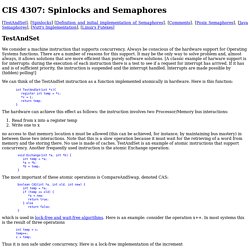
Always be conscious of the hardware support for Operating Systems functions. There are a number of reasons for this support. It may be the only way to solve problem and, almost always, it allows solutions that are more efficient than purely software solutions. We can think of the TestAndSet instruction as a function implemented atomically in hardware. Int TestAndSet(int *x){ register int temp = *x; *x = 1; return temp; } The hardware can achieve this effect as follows: the instruction involves two Processor/Memory bus interactions: Read from x into a register temp Write one to x no access to that memory location x must be allowed (this can be achieved, for instance, by maintaining bus mastery) in between those two interactions. Hyper-threading.
A high-level depiction of the Intel's Hyper-Threading Technology Hyper-threading (officially Hyper-Threading Technology or HT Technology, abbreviated HTT or HT) is Intel's proprietary simultaneous multithreading (SMT) implementation used to improve parallelization of computations (doing multiple tasks at once) performed on x86 microprocessors.
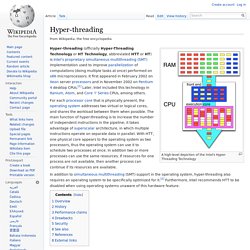
It first appeared in February 2002 on Xeon server processors and in November 2002 on Pentium 4 desktop CPUs.[1] Later, Intel included this technology in Itanium, Atom, and Core 'i' Series CPUs, among others. For each processor core that is physically present, the operating system addresses two virtual or logical cores, and shares the workload between them when possible. The main function of hyper-threading is to increase the number of independent instructions in the pipeline; it takes advantage of superscalar architecture, in which multiple instructions operate on separate data in parallel. Vol6iss1_hyper_threading_technology.pdf. Simultaneous multithreading. Details[edit] Multithreading is similar in concept to preemptive multitasking but is implemented at the thread level of execution in modern superscalar processors.
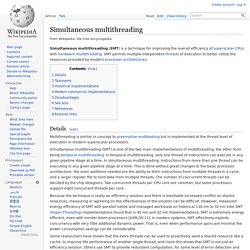
Simultaneous multithreading (SMT) is one of the two main implementations of multithreading, the other form being temporal multithreading. In temporal multithreading, only one thread of instructions can execute in any given pipeline stage at a time. In simultaneous multithreading, instructions from more than one thread can be executing in any given pipeline stage at a time. This is done without great changes to the basic processor architecture: the main additions needed are the ability to fetch instructions from multiple threads in a cycle, and a larger register file to hold data from multiple threads. Because the technique is really an efficiency solution and there is inevitable increased conflict on shared resources, measuring or agreeing on the effectiveness of the solution can be difficult.
Taxonomy[edit] The latest[when?] Multi core - Optimum number of threads while multitasking. [Solved] How to decide ideal number of threads ? Thin Lock vs. Futex. After my post on thin locks, several people asked me why not use a futex (fast userspace mutex) instead.

They referred to a Linux implementation described in “Fuss, Futexes and Furwocks: Fast Userlevel Locking in Linux” by Franke and Russel from IBM. The questions prompted me to do some research, and here’s what I’ve found. Multi-threaded programming: efficiency of locking. What is meant by fastpath and slowpath function in linux kernel? — Linux Kernel Newbies. Linux/Documentation/mutex-design.txt. 5.3. Semaphores and Mutexes. 5.3.
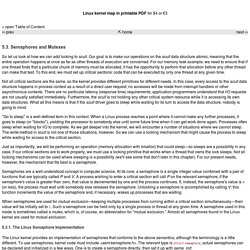
Semaphores and Mutexes So let us look at how we can add locking to scull. Our goal is to make our operations on the scull data structure atomic, meaning that the entire operation happens at once as far as other threads of execution are concerned. For our memory leak example, we need to ensure that if one thread finds that a particular chunk of memory must be allocated, it has the opportunity to perform that allocation before any other thread can make that test.
To this end, we must set up critical sections: code that can be executed by only one thread at any given time. Not all critical sections are the same, so the kernel provides different primitives for different needs. Spinlocks and Read-Write Locks. Most parallel programming in some way will involve the use of locking at the lowest levels.
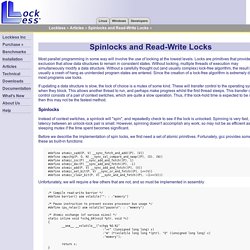
Locks are primitives that provide mutual exclusion that allow data structures to remain in consistent states. Without locking, multiple threads of execution may simultaneously modify a data structure. Without a carefully thought out (and usually complex) lock-free algorithm, the result is usually a crash of hang as unintended program states are entered. Since the creation of a lock-free algorithm is extremely difficult, most programs use locks. Futex.pdf. Mutexes and Condition Variables using Futexes. Mutexes and Condition Variables differ from spinlocks and spin read-write locks because they require threads to be able to sleep in some sort of wait-queue.

In order for this to happen, some communication is required with the operating system kernel via system calls. Since system calls are relatively slow compared to atomic instructions, we would like to minimize their number and avoid as many userspace-kernelspace context switches as possible. How does a mutex work? What does it cost? Concurrent programming requires synchronisation.

We can’t have more than one thread accessing data at the same time otherwise we end up with a data race. The most common solution is to wrap the critical data access in a mutex. Mutexes are, of course, not free. How the mutex is used has a significant impact in the cost of the code we are writing. When used correctly we’ll barely notice the overhead. Also view CPU Memory – Why do I need a mutex? How does a mutex work? What does it cost? Linux/include/linux/mutex.h. Nir Shavit's Home Page.